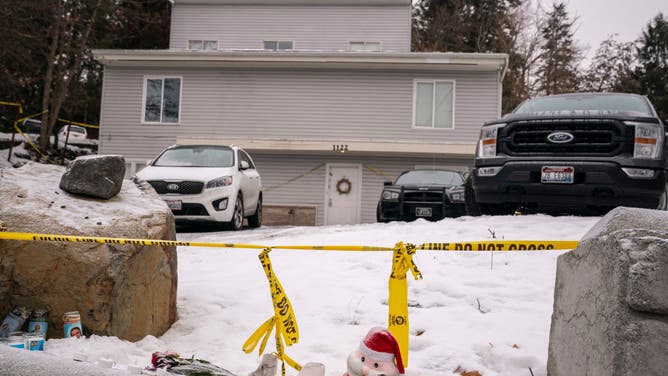Author Details Eerie, Untold Step-by-Step Account Of Idaho Murders
Nineteen months have passed since four college students – Maddie Mogen, 21; Kaylee Goncalves, 21; Xana Kernodle, 20; and Ethan Chapin, 20 – were stabbed to death in the now-demolished 122 King Road home in Moscow, Idaho on November 13, 2022.
Authorities arrested Bryan Kohberger, a 28-year-old graduate criminology student at Washington State University, as the sole suspect in the quadruple murder six weeks later.
A judicial gag order has prohibited two King Road house survivors, victims' family members, and law enforcement authorities from speaking about the case.
Other than the information from the initial police affidavit and a few stories leaked to the press, details about the case are limited.
Did Kohberger know the victims? Why would he target them? How did two of the six roommates go unharmed?
Author Howard Blum sought to find those answers in a new book titled "When the Night Comes Falling: A Requiem for the Idaho Student Murders," which went on sale today.
Blum claims he learned exactly what happened that night after interviewing many individuals with direct knowledge of the murders, most of whom spoke on the condition of anonymity.
On Friday, the author said during an interview with ABC that he believes Kohberger targeted only one of the four victims: Maddie Mogen.
He didn't explain why he thought that at the time. He saved the information for his book, of which the Daily Mail published an abbreviated version on Tuesday.
The opening sequence reads like the most eerie poem imaginable:
It was 3:30am on the cold, starlit November morning. The quiet was all enveloping.
Suddenly, a white car appeared. It was in no hurry.
Police reports describe how it crept along the street past 1122 King Road, before driving up an incline into a dead end and carefully executing a three-point turn.
The driver's face wasn't visible in the footage but his apparent calm belied reality.
I believe he was battling with himself… with his demons.
Thirty minutes later, surveillance video showed the white car driving back toward 1122, as if dragged by an invisible force.
Was this the killer stalking the house where six university students lived?
No, I suspect he was trying to find the will to do what he knew must be done to silence the howling banshees in his head.
Bryan Kohberger, I believe, then made his way down the dirt incline, mindful of the thin coating of frost on the ground.
In his gloved hand, I imagine him gripping a leather sheath that holds a Ka-Bar knife with its seven-inch steel blade.

MOSCOW, ID - Objects left for a makeshift memorial sit at the site of a quadruple murder on January 3, 2023. (Photo by David Ryder/Getty Images)
The author learned that the victims rarely locked the sliding glass door to their kitchen, including on the night of the murders. "The panel would have effortlessly glided open. Kohberger could have easily, almost silently stepped inside, Blum explains.
Per his reporting, Kohberger avoided the two adjacent second-floor bedrooms, where victims Xana Kernodle and Ethan Chapin slept. Rather, he proceeded up a narrow staircase to the third floor where the first killings occurred.
"And it is this fact that suggests to me that these murders weren't aimless. That there was intent." explains Blum. "Kohberger had a plan. And I believe it was to target Maddie Mogen and her alone."
Why Maddie?
The prosecution and the defense reportedly agree there is no evidence of any interaction between Mogen and Kohberger. Still, that doesn't mean the suspect and victim hadn't crossed paths or that Kohberger wasn't aware of Mogen.
Remember when Kohberger was arrested and it was reported that he requested the local jail accommodate his peculiar vegan diet? Blum believes Kohberger's strict diet led him to the Mad Greek restaurant on Main Street in Moscow, perhaps ground zero of the case that came to be known as the "Idaho Murders."
Mad Greek is the only restaurant in town to serve the type of vegan dishes that Kohberger's relatives say he prefers. Mogen also happened to wait tables there.
Could a simple waitress-to-patron interaction be enough for Kohberger, commonly described as a social pariah, to become jealous and resentful towards Mogen, a sparkling blonde known in the area for hosting popular parties at the King Road location?
Blum and other criminologists believe so.
"After this initial encounter at the Mad Greek, I suspect that Kohberger continued to follow Mogen and, at some point, obsession turned into murderous intent," reads the book. "Then, whenever 1122 King Road hosted a party - as they often did - he may have been watching from the shadows."
A source familiar with the case prosecutors presented to a grand jury informed the author that the prosecution believes the killer opened Mogen's bedroom door but was then panicked when he found another roommate in her bed, Kaylee Goncalves.
See, the killer would have had no way of knowing that Goncalves, who had a separate room on the third floor, would be asleep in Mogen's room. It's unclear why the women were in the same bed, though Goncalves had reportedly just returned home from an extended trip away.
"I suspect that Kohberger first slashed swiftly, savagely, at Mogen, before turning his blade on Goncalves," says Blum.
There were signs Goncalves fought back with the killer and managed to lift her body out of bed, which would explain the NewsNation report last December that her wounds were "significantly more brutal" than those of the other victims.
Sources cited in the piece say they believe Kohberger would have ended his killing spree there, knowing he had killed Mogen and impulsively killed her roommate. But then, unexpectedly, he was confronted by another soon-to-be victim – the sole male roommate in the home, Ethan Chapin.
"The bloody chaos in Mogen's room likely awakened Xana Kernodle on the floor below," Blum explains.
One of the surviving roommates, Dylan Mortensen, told the police she heard Kernodle, who lived on the second floor, cry out, "There's someone here!"
"Ethan Chapin, Kernodle's boyfriend, likely then left their room to investigate when he encountered Kohberger making his way back to the kitchen to escape," Blum continues.
"A medical examiner revealed to me that a single arcing blow sliced through Chapin's neck, catching the jugular. He fell in the second-floor stairwell doorway. Kohberger now likely realised he also had to deal with Kernodle, who may have watched her boyfriend's slaying."
Mortensen also told police she heard the killer utter a phrase to Kernodle, to the effect of, "It's okay, I'm going to help you." Kernodle was found dead inside her room.
Mortensen added that she peeked out of her second-floor bedroom three times around 4 am, once seeing a man whom she described as a "figure clad in black clothing and a mask" with "bushy eyebrows."
Blum theorizes the killer was in a state of shock from his manic episode by the time he spotted Mortensen, and thus couldn't bring himself to slay another roommate.
"The only reasonable explanation to me for why Mortensen is alive today is one that she and Kohberger were in parallel states of shock," he concluded. "Both were both locked so tight into their own private worlds – a young girl's terror, a killer's mania – that they couldn't think clearly."
The other surviving roommate, Bethany Funke, stayed in her room and didn't attempt to confront the killer. In fact, there is no evidence that she even woke up that night.
Mortensen explained to police that she was so traumatized and afraid after seeing the killer that she went back to sleep, stayed in her room until 11 am, and then called a friend who arrived to find the dead bodies and finally called the police.

MOSCOW, IDAHO - Bryan Kohberger, right, appears at a hearing in Latah County District Court on January 5, 2023, in Moscow, Idaho. Kohberger was arrested for the murders of four University of Idaho students in November 2022. (Photo by Ted S. Warren - Pool/Getty Images)
As for the – limited – evidence of which we are aware, it's strong.
Per the affidavit, police recovered a knife sheath left at the scene next to a fatally stabbed Mogen that contained Kohberger's DNA. The sheath was made for a rare Ka-Bar knife that police believed was used to slay the four roommates.
Last year, sources with knowledge of the investigation told NBC that Kohberger purchased a Ka-Bar knife and sheath from Amazon seven months before the murders.
Police also located cellphone pings that show Kohberger was in the area of the King Road home "at least 12 times" before the morning of the murders. His phone was shut off at the time of the stabbings.
He reappeared near the location of the home the next morning – perhaps looking for his knife sheath – but turned around.
Nonetheless, his lawyers claim to have an alibi to dispute his location the night of, one they will present in court. A trial for Kohberger has been continually postponed.
On August 29, a hearing will take place to argue the defense's request to move the trial from the small college town to elsewhere in the state. Kohberger's lawyers say that an impartial jury cannot be found in a small town too close to the scene of the murders.
If you have any thoughts about the case or Howard Blum's new book – which we encourage you to read, please, email us at robert.bruack@OutKick.com